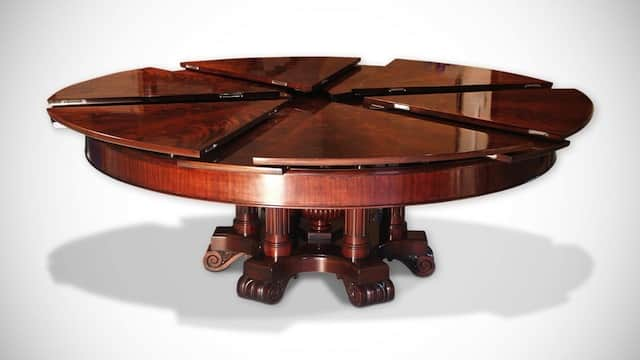
The amazing Capstan Table is designed by David Fletcher. This unique round table with a simple and chic design hides a marvelous secret. The table can expand from a small size to a larger one while maintaining its circular design during the process.
The Fletcher Capstan Table is produced and sold by a British luxury furniture maker Fletcher Burwell-Taylor. The original idea for a table of this type was formed in the nineteenth century by a man named Robert Jupe, who patented his design in 1835. Jupe’s table was initially round, and had an ingenious geometry and a similarly ingenious method of making it expand radically, changing from a small size to a table of larger diameter. However, these tables could not store their own expansion leaves, were not truly round in every stage, plus they were slow and laborious to operate. The idea was wonderful though and was a source of inspiration and re-invention.
The designer David Fletcher has been designing and manufacturing furniture for over thirty years. He started life in the antique business, dealing in English and continental furniture of the 17th and 18th centuries, and this gave him a strong understanding of form and proportion, taught him construction, and a knowledge and love of wood.
David has been working on his Capstan Table project since 1997. He has constantly improved the design to today’s sophisticated, standardised version. During this process he has developed his skills as a mechanical engineer and has committed every single one of the 5,000 odd separate components to 3D computer drawings. Whilst the company draws upon skilled craftsmen and high tech procedures in the manufacturing process, David is still very closely involved in every aspect of the construction and assembly of a table, and in fact normally performs on-site installations himself.
This unique and amazing table is capable of automatically doubling its seating capacity whilst remaining truly circular in the process. Expansion leaves are stored within the table and are self-positioning as the table changes from one mode and appearance to an entirely different one. Operation, which can either be manual or electronic, is simple and extremely quick.
The table top leaves are constructed from a sophisticated layering system and have, at their core, a layer of aluminium honeycomb. This gives them strength, rigidity, stability, and low weight. The table top is composed of thirteen self-stored elements and is capable of radial expansion by turning the top through 120 degrees. When small, the top is made up of six pie shaped leaves. Under this first layer lie two more layers of leaves, the second made up of six arrow shaped leaves and, under that, a large star shaped leaf.
The small table top is enclosed by an outer skirt in the manner of a drum table. This rises and falls as part of the expansion process and completes the table when it is small, making it truly round in both of its modes.
Beneath these parts lies a complex mechanism constructed primarily from stainless steel and hard anodised aluminium. The materials used are of such high specification that the table is capable of being permanently positioned on an exposed deck of a boat or in a beach house in the tropics. Every component used is of the highest quality and designed to last for generations.








